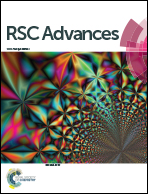Morphology fixing agent for [6,6]-phenyl C61-butyric acid methyl ester (PC60BM) in planar-type perovskite solar cells for enhanced stability†
Abstract
Here, we report that the delamination of [6,6]-phenyl C61-butyric acid methyl ester (PC60BM) from the CH3NH3PbI3 (MAPbI3) layer is a critical reason for the degradation of inverted perovskite solar cells (PSCs). In this work, an ∼10 nm-thick titanium oxide (TiOx) layer can function as a morphology-fixing agent for preventing PC60BM delamination, which in turn induces greatly improved long-term stability of the PSCs. In addition, the devices with the TiOx layer exhibited increased open circuit voltages, current densities, and fill factors, which correspond to improved initial device efficiency. Surface morphology changes of the PC60BM layer on the MAPbI3 layer during long-term operation of PSCs were confirmed by SEM and AFM, and were also found to be correlated with various electrical properties of the devices such as the hole mobility and charge generation and extraction efficiencies from the space-charge-limited current (SCLC) measurements and Jph versus Vint characterizations.
![Graphical abstract: Morphology fixing agent for [6,6]-phenyl C61-butyric acid methyl ester (PC60BM) in planar-type perovskite solar cells for enhanced stability](/en/Image/Get?imageInfo.ImageType=GA&imageInfo.ImageIdentifier.ManuscriptID=C6RA08584A&imageInfo.ImageIdentifier.Year=2016)

 Please wait while we load your content...
Please wait while we load your content...